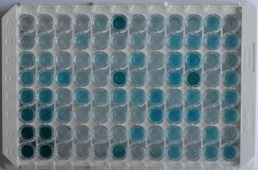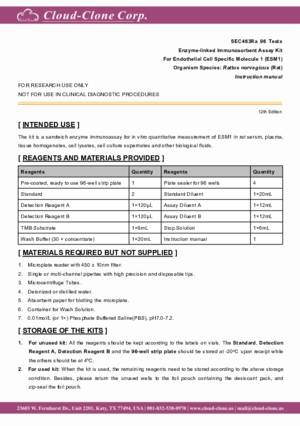Packages (Simulation)

Reagent Preparation

Image (I)
Image (II)
Certificate


ELISA Kit for Endothelial Cell Specific Molecule 1 (ESM1)
Endocan
- Product No.SEC463Ra
- Organism SpeciesRattus norvegicus (Rat) Same name, Different species.
- Sample TypeSerum, plasma, tissue homogenates, cell lysates, cell culture supernates and other biological fluids
- Test MethodDouble-antibody Sandwich
- Assay Length3h
- Detection Range0.156-10ng/mL
- SensitivityThe minimum detectable dose of this kit is typically less than 0.057ng/mL.
- DownloadInstruction Manual
- UOM 48T96T 96T*5 96T*10 96T*100
- FOB
US$ 532
US$ 760
US$ 3420
US$ 6460
US$ 53200
For more details, please contact local distributors!
Specificity
This assay has high sensitivity and excellent specificity for detection of Endothelial Cell Specific Molecule 1 (ESM1).
No significant cross-reactivity or interference between Endothelial Cell Specific Molecule 1 (ESM1) and analogues was observed.
Recovery
Matrices listed below were spiked with certain level of recombinant Endothelial Cell Specific Molecule 1 (ESM1) and the recovery rates were calculated by comparing the measured value to the expected amount of Endothelial Cell Specific Molecule 1 (ESM1) in samples.
| Matrix | Recovery range (%) | Average(%) |
| serum(n=5) | 81-88 | 84 |
| EDTA plasma(n=5) | 88-96 | 93 |
| heparin plasma(n=5) | 79-99 | 93 |
Precision
Intra-assay Precision (Precision within an assay): 3 samples with low, middle and high level Endothelial Cell Specific Molecule 1 (ESM1) were tested 20 times on one plate, respectively.
Inter-assay Precision (Precision between assays): 3 samples with low, middle and high level Endothelial Cell Specific Molecule 1 (ESM1) were tested on 3 different plates, 8 replicates in each plate.
CV(%) = SD/meanX100
Intra-Assay: CV<10%
Inter-Assay: CV<12%
Linearity
The linearity of the kit was assayed by testing samples spiked with appropriate concentration of Endothelial Cell Specific Molecule 1 (ESM1) and their serial dilutions. The results were demonstrated by the percentage of calculated concentration to the expected.
| Sample | 1:2 | 1:4 | 1:8 | 1:16 |
| serum(n=5) | 80-101% | 80-92% | 94-102% | 93-104% |
| EDTA plasma(n=5) | 98-105% | 78-97% | 87-95% | 81-96% |
| heparin plasma(n=5) | 81-104% | 96-103% | 93-101% | 83-102% |
Stability
The stability of kit is determined by the loss rate of activity. The loss rate of this kit is less than 5% within the expiration date under appropriate storage condition.
To minimize extra influence on the performance, operation procedures and lab conditions, especially room temperature, air humidity, incubator temperature should be strictly controlled. It is also strongly suggested that the whole assay is performed by the same operator from the beginning to the end.
Reagents and materials provided
| Reagents | Quantity | Reagents | Quantity |
| Pre-coated, ready to use 96-well strip plate | 1 | Plate sealer for 96 wells | 4 |
| Standard | 2 | Standard Diluent | 1×20mL |
| Detection Reagent A | 1×120µL | Assay Diluent A | 1×12mL |
| Detection Reagent B | 1×120µL | Assay Diluent B | 1×12mL |
| TMB Substrate | 1×9mL | Stop Solution | 1×6mL |
| Wash Buffer (30 × concentrate) | 1×20mL | Instruction manual | 1 |
Assay procedure summary
1. Prepare all reagents, samples and standards;
2. Add 100µL standard or sample to each well. Incubate 1 hours at 37°C;
3. Aspirate and add 100µL prepared Detection Reagent A. Incubate 1 hour at 37°C;
4. Aspirate and wash 3 times;
5. Add 100µL prepared Detection Reagent B. Incubate 30 minutes at 37°C;
6. Aspirate and wash 5 times;
7. Add 90µL Substrate Solution. Incubate 10-20 minutes at 37°C;
8. Add 50µL Stop Solution. Read at 450nm immediately.
GIVEAWAYS
INCREMENT SERVICES
-
 Single-component Reagents of Assay Kit
Single-component Reagents of Assay Kit
-
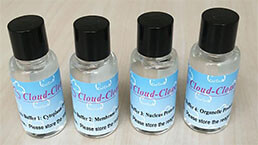 Lysis Buffer Specific for ELISA / CLIA
Lysis Buffer Specific for ELISA / CLIA
-
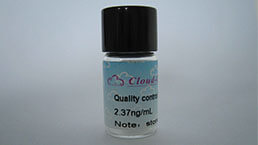 Quality Control of Kit
Quality Control of Kit
-
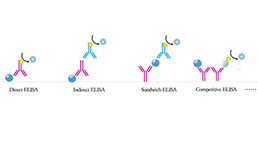 ELISA Kit Customized Service
ELISA Kit Customized Service
-
 Disease Model Customized Service
Disease Model Customized Service
-
 Serums Customized Service
Serums Customized Service
-
 TGFB1 Activation Reagent
TGFB1 Activation Reagent
-
 Real Time PCR Experimental Service
Real Time PCR Experimental Service
-
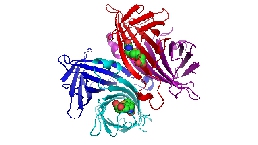 Streptavidin
Streptavidin
-
 Fast blue Protein Stain solution
Fast blue Protein Stain solution
-
 Single-component Reagents of FLIA Kit
Single-component Reagents of FLIA Kit
-
 Streptavidin-Agarose Beads
Streptavidin-Agarose Beads
| Magazine | Citations |
| Urology | Detection on dynamic changes of endothelial cell specific molecule-1 in acute rejection after renal transplantation PubMed: 22608803 |
| Microvasc Res. | Endocan is useful biomarker of survival and severity in sepsis. Pubmed: 24769132 |
| J Matern Fetal Neonatal Med. | Endocan, a putative endothelial cell marker, is elevated in preeclampsia, decreased in acute pyelonephritis, and unchanged in other obstetrical syndromes Pubmed:25211383 |
| Microvasc Res. | Endocan is useful biomarker of survival and severity in sepsis Pubmed:24769132 |
| Angiology | Endocan Levels and Subclinical Atherosclerosis in Patients With Systemic Lupus Erythematosus PubMed: 26614790 |
| Archives of Medical Science - Atherosclerotic Diseases | Assessment of subclinical cardiac damage in chronic plaque psoriasis patients: a case control study Journal:-102 |
| Int Immunopharmacol. | Inhibition of endocan attenuates monocrotaline-induced connective tissue disease related pulmonary arterial hypertension. pubmed:27912147 |
| Oncotarget | Diagnostic and prognostic values of endothelial-cell-specific molecule-1 with malignant pleural effusions in patients with non-small cell lung cancer pubmed:28514746 |
| Biomedical and Pharmacology Journal | Changes in Endocan Levels and Blood Coagulation in HIV Infection DOI: 10.13005/bpj/1082 |
| Life Sciences | A novel role of endocan in alleviating LPS-induced acute lung injury Pubmed:29627442 |
| International Urology and Nephrology | Is the plasma endocan level a reliable predictor for the severity of erectile dysfunction? Pubmed:30054863 |
| The Open Rheumatology Journal | Serum Level of Endothelial Cell-Specific Molecule-1 (ESM-1) as a New Potential Biomarker for Rheumatoid Arthritis Disease Activity Doi: 10.2174/1874312901812010189 |
| Molecular Medicine Reports | Downregulation of ENDOCAN in myeloid leukemia cells inhibits proliferation and promotes apoptosis by suppressing nuclear factor‑κB activity Pubmed: 30816462 |
| Biomarkers in Medicine | Endothelial biomarkers in the light of new sepsis definition Pubmed: 30920847 |
| Experimental and Therapeutic Medicine | Risk stratification and prognostic evaluation of endothelial cell‑specific molecule1, von Willebrand factor, and a disintegrin‑like and metalloprotease with … |
| Turkish Journal of Medical Sciences | A novel marker relationship between carotid intima–media thickness and disease activity score-28 in patients with rheumatoid arthritis: human endothelial cell … Pubmed: 31655533 |
| Biomarkers | Role of Ascitic Endocan Levels in the Diagnosis of Spontaneous Bacterial Peritonitis in Decompensated Cirrhosis Pubmed: 32364003 |
| J Obstet Gynaecol Res | Comparison of the maternal serum endocan levels in preterm premature rupture of membrane and normal pregnancy 34109715 |
| turkish journal clinics laboratory | The relationship between serum endocan levels with the presence of contrast-induced nephropathy in patients undergoing coronary angiography |
| Catalog No. | Related products for research use of Rattus norvegicus (Rat) Organism species | Applications (RESEARCH USE ONLY!) |
| RPC463Ra01 | Recombinant Endothelial Cell Specific Molecule 1 (ESM1) | Positive Control; Immunogen; SDS-PAGE; WB. |
| PAC463Ra01 | Polyclonal Antibody to Endothelial Cell Specific Molecule 1 (ESM1) | WB; IHC; ICC; IP. |
| LAC463Ra71 | Biotin-Linked Polyclonal Antibody to Endothelial Cell Specific Molecule 1 (ESM1) | WB; IHC; ICC. |
| SEC463Ra | ELISA Kit for Endothelial Cell Specific Molecule 1 (ESM1) | Enzyme-linked immunosorbent assay for Antigen Detection. |
| LMC463Ra | Multiplex Assay Kit for Endothelial Cell Specific Molecule 1 (ESM1) ,etc. by FLIA (Flow Luminescence Immunoassay) | FLIA Kit for Antigen Detection. |

